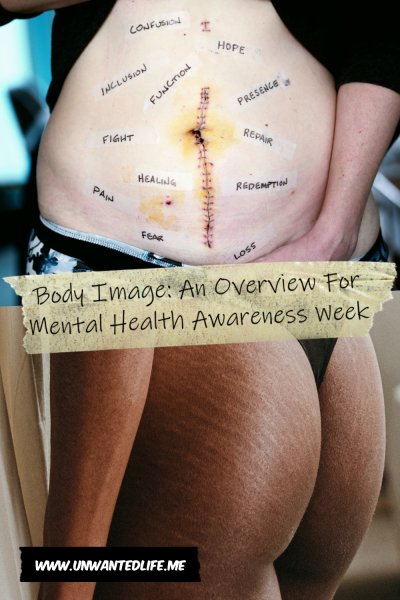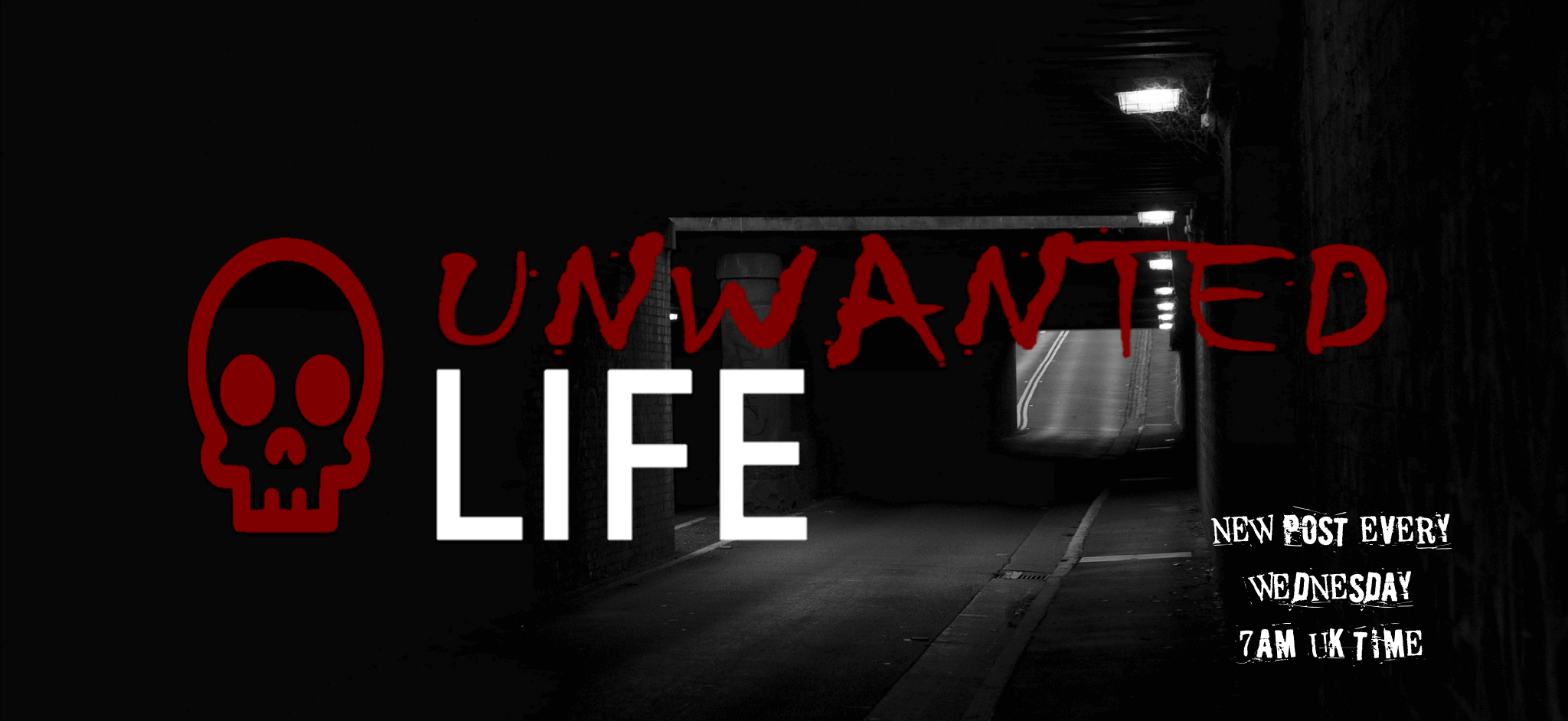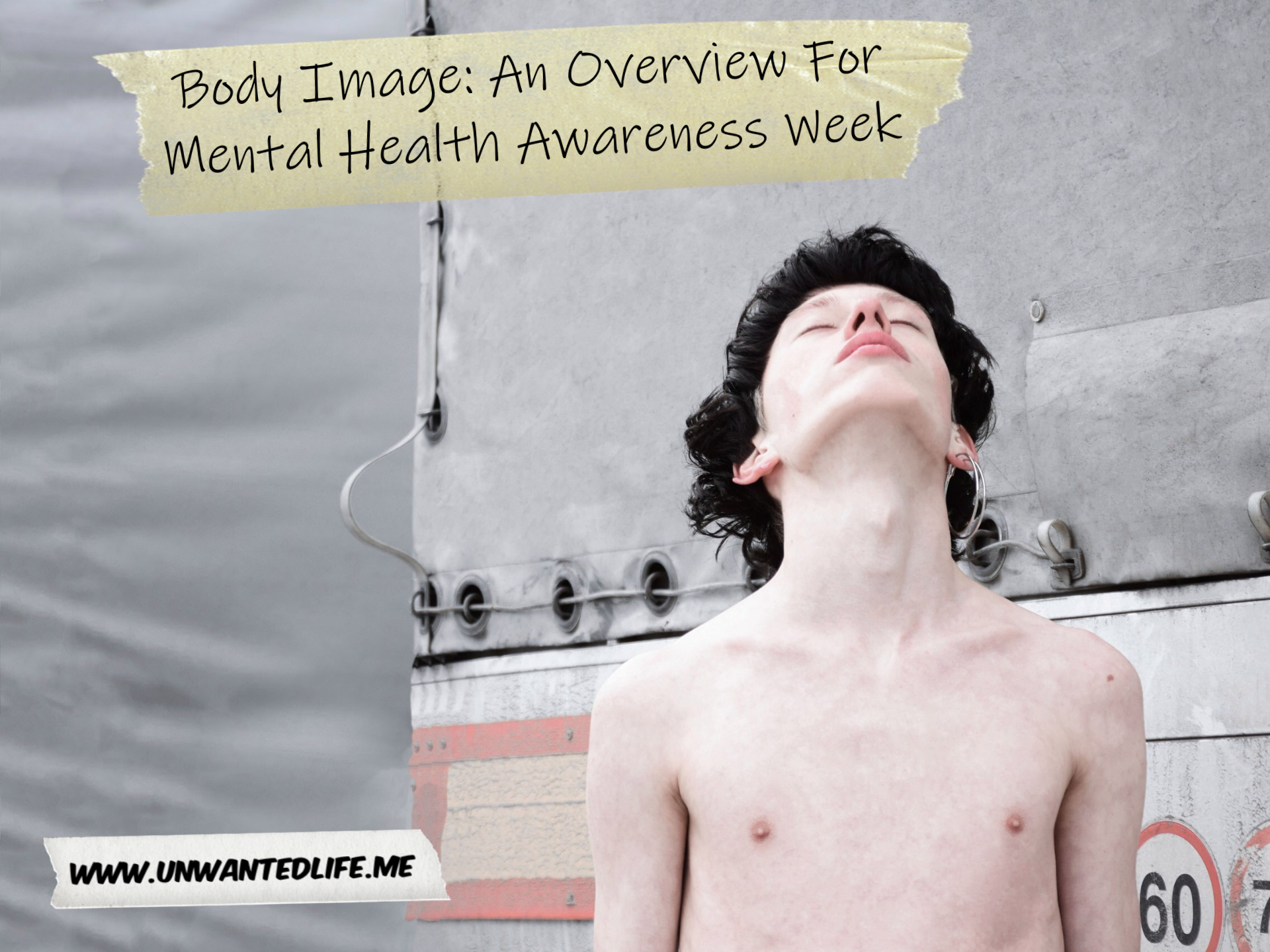In honour of #MentalHealthAwarenessWeek, I thought I’d put together a article about this year’s topic as selected by the Mental Health Foundation: body image. Hopefully, this article will help people fully appreciate how much body image can play a role in our mental wellbeing.
If you’ve read my previous article about My Relationship With Food, you’ll understand how I’ve struggled with an eating disorder and body image problems (largely due to racism – Suicidal Child). How we think and feel about our bodies can have a lasting impact on both our physical and mental health. Often our views on our body image develop in childhood, which then goes on to shape the rest of our lives. Thus, we all need to learn how to #BeBodyKind in order to live happier lives.
This makes body image an important part of everyone’s mental health. In order to have a greater sense of overall well-being, you need to be secure with your body (Mental Health Foundation). Thus, the happier you are with your body, the happier you are mentally. This is why body image is the topic of this year’s #MentalHealthAwarenessWeek.
Body Image Statistics
To put this problem into perspective, let’s take a look at some of the statistics. According to Park Nicollet Melrose Center, as much as 80% of women and 34% of men are unhappy with their bodies and how they look in the US. Furthermore, over 50% of people from the US aren’t happy with their weight, and 70% of women who are of average weight wished they were thinner.
The National Citizens Service (as cited by Cordell Health) discovered that 27% of teens cared about their appearance more than their physical health. Such views would explain why people are willing to engage in behaviours that are dangerous to their health in an attempt to “look better”.
According to the Mental Health Foundation, they found that 30% of adults have found themselves unable to cope due to the stress caused by their appearance and body image. That equates to almost a 1 in 3 people. The fact that almost 1 in 3 people are overwhelmed with stress about how they look is alarming. It also further highlights just how serious a problem this is for society.
I know I’ve always had problems with my body image, ranging from my arms being too skinny, my ribs sticking out too much, my ankles being too skinny, my feet too long and thin, etc. It’s just a never-ending headache of worries about how I look. Causing issues with my anxiety disorders (The Weirdness Of My Anxiety Disorders) and even leading me to try doing stupid extreme diets that just set me up to fail (Dieting To Misery: Being Overweight).
Body image problems don’t discriminate, unlike people, and can affect anyone. Whether it’s a need to feel muscular or skinny, people are at risk of feeling the pressure to conform to the expected societal norms. For example, 34% of young men feel the pressure to have a muscular physique, and 55% of young women feel the pressure to be skinny (The National Citizens Service, as cited by Cordell Health).
So where does this pressure come from? It comes from family, friends, and peers, often indirectly rather than directly. By that, I mean that a parent could talk about how overweight they are in a very negative way, which will then teach their children that being overweight is a really bad thing.
Our societal norms are also influenced by how the media represents body image. Magazines, especially ones aimed at young women, tend to devote a lot of their content to appearance. Park Nicollet Melrose Center found that magazines aimed at women had almost 10 times the content on dieting and weight loss than their male equivalents.

Oddly, body image campaigns only really address women of all sizes to sell products, whilst the male representation still seems to be focusing on muscular perfection. Just goes to show the stigma around male body issues still isn’t being taken as seriously when it comes to trying to get us to buy their products.
More often than not, TV shows, advertising, and films all revolve around thin or muscular and healthy-looking people. Everywhere you look or go, you’ll be greeted by images of people with perfectly formed bodies because sex sells. The problem is, it’s not good for us to be constantly assaulted with these impossible representations of what we should look like or aspire to be.
What highlights this the most for me is a study done in Fiji. In 1994, Fiji got its first permanent commercial TV broadcasting network. Due to this, it allowed researchers to conduct studies into the impact of introducing TV to a TV naïve society. Prior to the introduction of television to the nation, a larger robust body image was the accepted norm.
However, after the introduction of television, this norm started to shift. As reported by the BBC, 38 months after the introduction of the island’s first permanent TV network, a survey of native Fijian teenage girls found that 74% of them now felt they were “fat” with 15% reporting they had induced vomiting to control weight.
Furthermore, the New York Times reported on the same study which found that girls who watched TV on 3+ nights a week were 50% more likely to call themselves “fat” and 30% more likely to diet than the girls who watched TV less often.
This is why body image is an important area to be concerned about. Additionally, when your body image starts to affect your ability to do the normal things you used to do, or when you become fixated on your appearance, you could have a body dysmorphic disorder.
Signs And Symptoms Of Body Dysmorphic Disorder
- Being extremely preoccupied with a perceived flaw in appearance that to others can’t be seen or appears minor (Mayo Clinic).
- Spend a lot of time comparing your looks with other people’s (NHS).
- Repeatedly checking the perceived defects in mirrors and other reflecting surfaces, such as windows or a cell phones (International OCD Foundation).
- Obsessively checking your appearance in mirrors, or avoiding mirrors completely (Mind).
- A strong belief that you have a defect in your appearance that makes you ugly or deformed (Mayo Clinic).
- The belief that others take special notice of your appearance in a negative way or mock you (Mayo Clinic).
- Go to a lot of effort to conceal flaws. For example, by spending a long time combing your hair, applying make-up, or choosing clothes (NHS).
- Constantly comparing yourself with models in magazines or people in the street (Mind).
- Always seeking reassurance about your appearance from others (Mayo Clinic).
- Engaging in behaviours aimed at fixing or hiding the perceived flaw that is difficult to resist or control, such as frequently checking the mirror, grooming, or skin picking (Mayo Clinic).
- Having perfectionist tendencies (Mayo Clinic).
- Social anxiety and social avoidance are very common in people with body dysmorphic disorder, which may cause body dysmorphic disorder to be misdiagnosed as a social anxiety disorder (social phobia). Social anxiety and avoidance may be caused by fears that other people will see the perceived appearance flaws and look down on, reject, or ridicule the person (International OCD Foundation).
- Being so preoccupied with appearance that it causes major distress or problems in your social life, work, school or other areas of functioning (Mayo Clinic).
- Seeking cosmetic surgery or having other types of medical treatment to change the area of concern (Mind).
- Excessively tanning to darken skin that is considered too pale or for other reasons. For example, to minimise perceived acne (International OCD Foundation).
- Frequent weighing (Mind).
Because we have a tendency to internalise the messages we hear about how people look, we’re at risk of developing a negative body image if the messages we internalise are negative. If, however, the messages we internalise are positive, then we’ll develop a positive body image.
Having a positive body image is important to our wellbeing, and it protects us from developing an eating disorder.
According to the National Eating Disorders Association, this is because a negative body image involves a distorted perception of how we look. This can cause anxiety, shame, and low self-esteem. Thus, people who are dissatisfied with their bodies and feel they’re somehow flawed when compared to others are at greater risk of feeling depressed, isolating themselves, and developing an eating disorder.
Eating Disorders
An eating disorder is when a person develops an unhealthy relationship with food. This can mean the person either eats too much, or too little or becomes all consumed by their body shape and weight. Thus, the resulting unhealthy attitude towards food can then take over their lives and even make them seriously ill: in extreme cases, people have died because of their eating disorder.
The statistics
Information collected from the Dove Self-Esteem Project found that 9 out of 10 (87%) women will avoid, or stop themselves, from eating. I’m guilty of this behaviour myself (Did Poor Mental Health Cause My Unhealthy Relationship With Food?).
Between 30-50% of eating disorder patients suffered from depression and/or anxiety prior to developing their eating disorder (The Body Image Therapy Center). This highlights just how important a role our mental health plays regarding our body image and developing an eating disorder.
Shockingly, by the age of 17, a whopping 89% of girls have tried dieting, and if that wasn’t bad enough, 51% of girls aged 9-10 state that they feel better about themselves when they are dieting (The Body Image Therapy Center). It’s disturbing to learn that girls of such a young age are already taking steps to conform to the idea that skinny is best when it’s not.
Furthermore, 81% of 10-year-olds are scared of being fat, so it’s not so surprising that 9% of nine-year-olds have vomited to lose weight (The Body Image Therapy Center). Children shouldn’t be worrying about their weight and instead should be enjoying being a child before their childhood is over. This makes installing good positive body image messages in our children really important.
This matters because the rate of death for women with an eating disorder is 12 times higher than their female peers. About 1,000 women die each year from malnutrition, heart attacks, and suicide due to their eating disorders (The Body Image Therapy Center).
But it’s not just the damage it can cause to our health that matters, it’s also how it impacts our everyday lives. The Dove Self-Esteem Project also found that 7 in 10 girls wouldn’t be assertive in their opinions or stick by their decisions if they have low body esteem and were unhappy with the way they looked. Girls shouldn’t believe their opinions don’t matter because they don’t fit society’s definition of a good body, nor are their decisions any less valid because of it.
But it’s not just women that are affected by eating disorders. If you’ve read my previous article, you’ll already be aware of some of the male eating disorder statistics. One of the statistics in that article came from an article called “One Man’s Battle with Bulimia” which stated that eating disorders are typically viewed as a female condition, yet up to 25% of sufferers are male (Men’s Health).
Furthermore, 40% of those with binge-eating disorders are male, according to Eating Disorder Hope. Thus, eating disorders really aren’t just a female problem.

Causes/signs of eating disorders
- Major life transitions like puberty, entering high school/college, major losses, or trauma.
- Preoccupation with and/or secretive behaviour around food.
- Missing meals.
- Family problems.
- Social difficulties like teasing, bullying, or ridicule.
- Self-consciousness when eating in front of others.
- Fear of failure or a need to be perfect (often related to dieting)
- Traumatic events like sexual and physical abuse.
- Complaining of being fat, even though they have a normal weight or are underweight.
- Psychiatric illnesses like depression, anxiety, obsessive-compulsive disorder, and attention deficit disorder (ADHD).
- Tiredness.
- Personality traits like low self-esteem, difficulty with change, and fear of feeling out of control.
- Changes in personality.
Lastly, 69% of women and 65% of girls claim pressure from the media and advertisements’ portrayals of unrealistic beauty standards causes them to develop anxiety about their body image (Dove Self-Esteem Project).
In the past, body image concerns were deemed to only be a female problem. However, if you look at the messages being projected in our media and by society today, you can clearly see the example of unrealistic body image standards for boys/men (Eating Disorder Hope). This is due to the special set of pressures to be masculine, which leads us to muscle dysmorphia.
Body Image: Muscle Dysmorphia
Body image in men can be different from women, which often makes it an overlooked area of research. Just trying to create this post has shown me how hard it is to find statistics about male eating disorders and body image. Whereas it’s extremely easy to find statistics about women.
Unlike other body image disorders which tend to affect women more than men, muscle dysmorphia tends to affect more men than women.
Some of the common concerns among straight men are their body weight, penis size, height, and, to a lesser extent on muscularity, head hair, and body hair. Thus, men feel they have to be muscular and lean, have a big penis, have their own full head of hair, be tall, and remove their body hair.
Because of this, muscle dysmorphia (or bigorexia, if you will) is an anxiety disorder that causes a person (more often men) to see themselves as small, despite being big and muscular (BBC Newsbeat). This is important because, just like other body image disorders, it can lead to depression, anxiety, suicidal behaviour, as well as addiction (steroids).
One of the biggest dangers of this disorder in men, as reported by The Guardian, is the increase in anabolic steroid use. Reporting on The Home Office’s crime survey, The Guardian noted that there was an increase in 16-24-year-olds using the drug, equating to an additional 19,000 young men.

The statistics
Unfortunately, digging up statistics on this disorder is no easy task. Muscle dysmorphia is still an under-reported condition.
However, Mirror Mirror (unfortunately, the web page no longer exists) has stated on its site that between 50-100% of men with muscle dysmorphia report steroid abuse, according to some studies. Which, if true, would support what The Guardian reported about The Home Office’s crime survey.
It is also believed that 1 in 10 gym-going men suffer from muscle dysmorphia, as reported by BBC Newsbeat. A similar figure was reported by Mirror Mirror (unfortunately, the web page no longer exists), which stated that approximately 10% of bodybuilders might have muscle dysmorphia, according to preliminary research.
Mirror Mirror (unfortunately, the web page no longer exists) goes on to claim that the potential rates of male muscle dysmorphia could be similar to that of anorexia in women. If true, that would equate to millions of men suffering from muscle dysmorphia. This would be a staggering figure if it could be proven to be true. However, as of yet, such claims haven’t been proven, largely due to the difficulty of finding people seeking help for the disorder.
Signs of muscle dysmorphia
- Overexertion at the gym (BBC Newsbeat).
- Working out in spite of injury.
- Working out compulsively (BBC Newsbeat).
- Preoccupation with body image, in particular, the wish to look muscular.
- Use of anabolic steroids (BBC Newsbeat).
- Constantly scrutinising oneself in the mirror or avoiding looking in the mirror entirely.
- Abuse of supplements and constant drinking of protein shakes (BBC Newsbeat).
- Intense fear of losing weight and ‘withering away’.
- Irritability and angry outbursts (BBC Newsbeat).
- Feel anxious or distressed if you miss a session of working out or experience even a slight deviation from your strict diet.
- Depression and mania (BBC Newsbeat).
- Avoidance of situations where the individual’s body could be exposed due to feelings of inadequacy.
- Frequently giving up social activities or work obligations because of a compulsive need to maintain one’s workout and diet schedule.
After reading these signs of muscle dysmorphia, you might have suddenly realised that you might know someone who could suffer from this. You might not have realised this before because such people are considered to be healthy. Eating right and exercising are what we’re all told to do in order to be healthy, so it wouldn’t cross our minds that some people are taking this to an extremely unhealthy level. But people do, and they also need help, just like any other body image disorder.
As with other body image disorders, the media also plays its part in the development of this condition. The constant presentation of extremely muscular well-groomed men is having the same impact on men as the “beach body ready” stuff women are subjected to. As such, there needs to be a movement that targets men and pushes for body positivity, just like you see happening within the media when aiming at women. Where are the Dove style campaigns of men of different body shapes and sizes marketing male products?
Tips for Body Image Disorders
What can be done to try to avoid developing a body image disorder? Well, hopefully, some of the following suggestions will be useful in these regards:
- Help boys understand there is no need to hyper-control their bodies. Both boys and girls need to undo the mistaken notion that the body can be shaped and moulded, at will, to fit a cookie-cutter image of the perfect body (Eating Disorder Hope).
- Remind yourself about how the media uses Photoshop, picture manipulation, lighting, and filters to create the so-called ideal body. Then remind others of this fact and teach your children about it as well.
- Use the time and energy that you might have spent worrying about food, calories, and weight to do something to help others (National Eating Disorders Association).
- If you know someone who is suffering from a body image disorder, then talk to them. Ask if things are okay if there’s anything they want to talk about, and if there’s anything that would help. Remember, they’re still a person and more than just their disorder (Beat).
- Remind yourself that “true beauty” is not simply skin-deep (National Eating Disorders Association).
- When watching TV with your children, talk about the body image message that is being portrayed.
- Sometimes just making time to do activities together provides the best opportunity for dialogue and exchange.
- Show them how “ideal” body shapes have changed over time (Park Nicollet Melrose Center).
- Educate yourself about body image and body image disorders.
- Keep a top-ten list of things you like about yourself (National Eating Disorders Association).
- Help boys understand that to fit in, they don’t have to be muscle-bound and super-athletes (Eating Disorder Hope).
- Stop talking about your and other people’s bodies in a negative way, I know I’m guilty of doing this.
- Work with your body, not against it.
- Complete a pros/cons list of getting well (International OCD Foundation).
- Help boys understand that most kinds of power do not come with big muscles and a “might makes right” attitude (Eating Disorder Hope).
- Create an environment where your children feel safe and able to talk to you about the concerns they have about their bodies.
- It is easier to feel good about yourself and your body when you are around others who are supportive and who recognize the importance of liking yourself just as you naturally are (National Eating Disorders Association).
- Figure out your triggers in order to create a way to cope with them in the future
- Make a list of what their life would be like without your/their body image disorder (International OCD Foundation).
- Celebrate their successes. Stopping compulsive behaviours can be very difficult and it will take time. Celebrating the small steps, such as spending less time grooming or carrying out fewer repetitions, can help keep your loved one motivated (Mind).
Lastly, if you’re already suffering from a body image problem, then seek professional help, and reach out to support groups and constant support services.
Let me know in the comments section below what you thought of my body image article for Mental Health Awareness Week. Have any of you suffered from, or are suffering from, a body image disorder? If you’re ok with sharing, then let us know in the comments section below as well. If you want to stay up-to-date with my blog, then sign up for my newsletter below. Alternatively, get push notifications for new articles by clicking the red bell icon in the bottom right corner.
Lastly, if you’d like to support my blog, then you can make a donation of any size below as well. Until next time, Unwanted Life readers.
Support
For more information on body dysmorphic disorder, please visit:
For more information on eating disorders, please visit:
For more information on muscle dysmorphia, please visit:


Wow a very long but extra informative post! I always had a great body younger… Not skinny but just a little thick. I was always in general a size 10. I’m now almost double and I’m older too ~ I’m more comfy with me than I ever was. Guys live think women bc they say they don’t want bones to poke them … Plus when your in Golden years skinny only means one thing ~ wrinkles ~
Love yourself is key to accepting yourself at whatever size you may be! I left my info on your post on Twitter for you return my follow n comment
Great job ❤️???
I did get a bit carried away with this piece it seems ha ha ha
Very informative post! I personally suffered from eating disorders therefore I personally know how this affects you emotionally and mentally, I love how much awareness this post creates! Great info!
Thank you